I DO NOT proclaim to be the person with the answers just someone who wants to share information among us brothers against fish LOL
Why you should read this ……..
You may think this doesn’t pertain to you may be a chunker, you may be a troller or a live bait person and the last thing you probably thought about was throwing top water poppers … but think again. Have you ever had the following happen?
You spot a school of tuna, you troll and troll and troll but they just won’t feed. You should always have one set up for casting in case this happens, you will increase you chances of hooking up dramatically. Last year on several trips this has saved the day for many people. Variety is the spice of life and knowledge is power, embrace and execute for success
Or …
Your marking tuna or fish 50’ down but they wont eat your chunks or jigs, break out a huge cup popper or a shiny swim bait and watch them fight over it and raise.
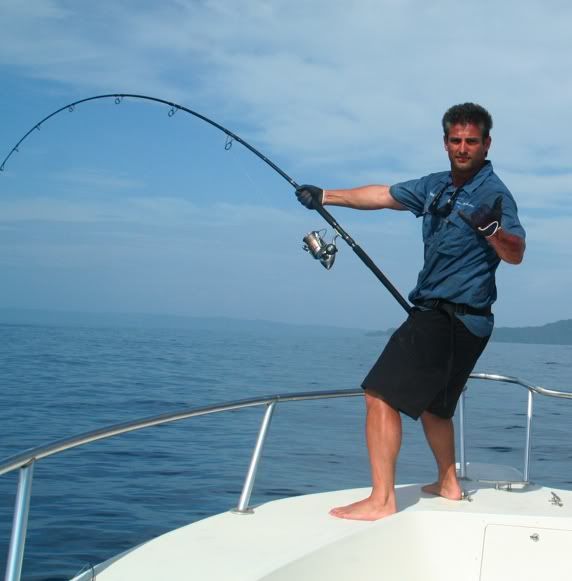
I have spent the last several years chasing large game fish such as Yelowfin Tuna & Marlin on topwater all over the world from PV, Cabo, Panama and off Cape Cod for large bluefins. This article will be based on casting to tuna however the same principles can be used when casting to almost any pelagic, these techniques work on everything from Amberjack – Marlin.
Here is the scene and why its so addictive .....
You get the call, “We found them, boiling tuna, get you ass over here”. In an instant your heart is racing as the throttles of the boat are pushed to full and your off and racing 10 miles in 3-foot seas with pouring rain in your face. The small spec on the horizon gets bigger and bigger, which is your friends boat. On the way you frantically check and re check your hooks, your leader, your connections as you’re pounded by the waves, hoping & praying you’re not to late. You wipe the burning salt water out of your eyes to get a better look at the horizon.
The first thing you notice as you get closer is the black sky and the white water beneath it but as you near the area you realize that the black sky is birds diving frantically into the white water below. It’s hard to make at first what’s under the birds but as you slow down and approach with the wind at your back you can see the spinner dolphin feeding and there is rolling tuna everywhere. WIDE OPEN BITE … a once in a lifetime bite
A wide-open natural feed predators, baitfish skyrocketing everywhere desperately fleeing for their lives. You can sense the desperation as baitfish are frantically jumping anywhere and everywhere including the boat. Absolutely pure chaos all within a small area and as you arrive you see your friends on the other boat in obvious pain and bent over fighting the unknown.
You calm yourself down, steady yourself in the bow and with a strong powerful cast launch your popper into the violently frothing ocean … Flip the bail of your Stella ... long pull CHUG … Long pull CHUG … long pull CHUG a boil behind you!!! C’mon take it take it, take it Biatch zzzzzzzzzzzzzzzzzzzzz zzzzzzzzzzzzzzzzzzzzzzzzz ZZZZZZZzzzzzzzzz you’re tight. The huge yellowfin races along the surface for a moment before plunging to the depths below peeling off massive amounts of line.
Your about to do battle with a beast in an un conventional way, I hope you brought you’re A-Game because he bought his. The battle goes vertical after an initial long run and after a battle the circles get smaller, and the goal is in reach one more turn, that’s all I need. Stick her, stick her!!!!!! The gaff reaches out and the shot is made in the head. All you see is blood red water; all you hear is your heartbeat and that tail whacking the water. Another gaff goes in and over the side she goes with a thud on the deck your dream has been realized. Now put away so I can cast again..
WELCOME TO HEAVEN ... isnt it frigging awesome !!!!!!!
The first thing you notice as you get closer is the black sky and the white water beneath it but as you near the area you realize that the black sky is birds diving frantically into the white water below. It’s hard to make at first what’s under the birds but as you slow down and approach with the wind at your back you can see the spinner dolphin feeding and there is rolling tuna everywhere. WIDE OPEN BITE … a once in a lifetime bite
A wide-open natural feed predators, baitfish skyrocketing everywhere desperately fleeing for their lives. You can sense the desperation as baitfish are frantically jumping anywhere and everywhere including the boat. Absolutely pure chaos all within a small area and as you arrive you see your friends on the other boat in obvious pain and bent over fighting the unknown.
You calm yourself down, steady yourself in the bow and with a strong powerful cast launch your popper into the violently frothing ocean … Flip the bail of your Stella ... long pull CHUG … Long pull CHUG … long pull CHUG a boil behind you!!! C’mon take it take it, take it Biatch zzzzzzzzzzzzzzzzzzzzz zzzzzzzzzzzzzzzzzzzzzzzzz ZZZZZZZzzzzzzzzz you’re tight. The huge yellowfin races along the surface for a moment before plunging to the depths below peeling off massive amounts of line.
Your about to do battle with a beast in an un conventional way, I hope you brought you’re A-Game because he bought his. The battle goes vertical after an initial long run and after a battle the circles get smaller, and the goal is in reach one more turn, that’s all I need. Stick her, stick her!!!!!! The gaff reaches out and the shot is made in the head. All you see is blood red water; all you hear is your heartbeat and that tail whacking the water. Another gaff goes in and over the side she goes with a thud on the deck your dream has been realized. Now put away so I can cast again..
WELCOME TO HEAVEN ... isnt it frigging awesome !!!!!!!
TIP – Make sure you buy a high-speed reel that can accommodate at least 300 yards of 65-80 pound braid and produce at least 25 pounds of drag. Chasing big tuna can get hairy on the first run and having enough capacity always helps you land that trophy
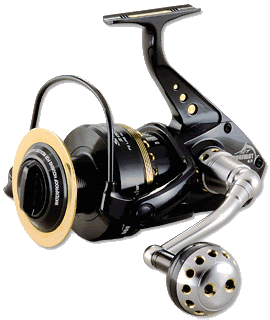
I also really suggest using a reel like the new Shimano Stella because of the new Casting lip, it makes the line flow off the reel at a much more efficient manner and helps your distance significantly
I will not be covering conventional reels, as 99 percent of anglers will be using spinning reels. The general rule of thumb for casting is to use the highest gear possible. This will allow you to work your artificial properly whether it’s keeping a swim bait moving during the whole retrieve or chugging a big popper.

You can use a lower gear reel if that all you have for poppers but not swim baits, and I don’t suggest it but sometimes financial situations may not allow you to have both models and will make life very easy on you.
TOP SHELF INVESTMENT Spinning Reels – My first choices from $600-$1,000
SHIMANO STELLA - JPD or Japanese Domestic Models
1. Stella 18000 HG at 5.7:1, 55 pounds of drag,
2. Stella 10000XG at 5.8:1 and 55 pounds of drag
3. Stella 8000HG at 5.6:1 and 55 pounds of drag
SHIMANO STELLA USA model
1. Stella 18000SW at 5.7-1 and 55 pounds of drag
2. 10000SW at 5.8 and 55 pounds of drag
3. 80000SW, which is 5.6:1, and 55 pounds of drag
DIAWA
1.Diawa Satiga-Z 6500 Dogfight at 6.2:1 and 60 pounds of drag
2.Diawa Saltiga Z 6000GT at 6.2:1 and 60 pounds of drag
ACCURATE
1. Accurate Twin Spin SR 30 at 6:1 and 40 pounds of drag
2. Accurate Twin Spin SR 20 at 5:1 and 30 pounds of drag
MIDDLE OF THE ROAD $200-$650
1. Shimano Twin Power 12000HG at 5.6 and 40 pounds of drag
2. Quantum Cabo 80PT at 4.9:1 and 30 pounds of drag
3. Shimano Spheros 14000
4. Penn Sportfisher SS 850 at 4.6:1
5. Quantum Boca 80 at 4.9:1

I also really suggest using a reel like the new Shimano Stella because of the new Casting lip, it makes the line flow off the reel at a much more efficient manner and helps your distance significantly
I will not be covering conventional reels, as 99 percent of anglers will be using spinning reels. The general rule of thumb for casting is to use the highest gear possible. This will allow you to work your artificial properly whether it’s keeping a swim bait moving during the whole retrieve or chugging a big popper.

You can use a lower gear reel if that all you have for poppers but not swim baits, and I don’t suggest it but sometimes financial situations may not allow you to have both models and will make life very easy on you.
TOP SHELF INVESTMENT Spinning Reels – My first choices from $600-$1,000
SHIMANO STELLA - JPD or Japanese Domestic Models
1. Stella 18000 HG at 5.7:1, 55 pounds of drag,
2. Stella 10000XG at 5.8:1 and 55 pounds of drag
3. Stella 8000HG at 5.6:1 and 55 pounds of drag
SHIMANO STELLA USA model
1. Stella 18000SW at 5.7-1 and 55 pounds of drag
2. 10000SW at 5.8 and 55 pounds of drag
3. 80000SW, which is 5.6:1, and 55 pounds of drag
DIAWA
1.Diawa Satiga-Z 6500 Dogfight at 6.2:1 and 60 pounds of drag
2.Diawa Saltiga Z 6000GT at 6.2:1 and 60 pounds of drag
ACCURATE
1. Accurate Twin Spin SR 30 at 6:1 and 40 pounds of drag
2. Accurate Twin Spin SR 20 at 5:1 and 30 pounds of drag
MIDDLE OF THE ROAD $200-$650
1. Shimano Twin Power 12000HG at 5.6 and 40 pounds of drag
2. Quantum Cabo 80PT at 4.9:1 and 30 pounds of drag
3. Shimano Spheros 14000
4. Penn Sportfisher SS 850 at 4.6:1
5. Quantum Boca 80 at 4.9:1
Popping Rods
TIP – Pick a rod that suites your needs not the “IN” rod. Everyone’s bodies are different therefore each rod will fit you different. If you know you will cast 105g rods pick the best rod in that class that you love, not what everyone else buys because only one person will fight that trophy and its you not them. Match your body and fighting style to the right rod
The length debate continues the sooner you come to grips with using a longer rod the better you will be because in casting length is an important factor especially on those days when the fish don’t stay up on top for long. You may get 5 casts into the school before they dive so you need to make them count
FEATURES & BENEFITS …. WHAT TO LOOK FOR
For the most part the descriptions I used for jigging rods really hold true here as well with some minor differences
Lightweight – weight is very important, especially when you are throwing 100g (3.5 ounce) - 200g (7 ounce) poppers all day in the sun so you will need a light rod so you can cast all day without fatigue.
Balanced – Because of the amount of casting you will do you will need a well balanced rod so u can properly work the popper. Plus with a totally balanced rod you will have more control and leverage over your fish
Power – You want a rod that will have backbone but at the same time bend with the fish. Too much backbone and your back with kill you and the rod will be heavier, not enough and it will take hours to land your fish. Most casting rods power will be about 6” above the upper grip.
Action – Unlike jigging rods where you have the ability to chose a parabolic rod in casting you really don’t use parabolic rods because of the length. A good casting rod with proper backbone will deflect stress off you and into the fish.
Tip – Depending on your choice of weapons, stick bait or popper the tip sections will become more important but the tip must be flexible so you can properly load the rod when casting to maximize casting distance but still have enough stiffness to work the lure
The length debate continues the sooner you come to grips with using a longer rod the better you will be because in casting length is an important factor especially on those days when the fish don’t stay up on top for long. You may get 5 casts into the school before they dive so you need to make them count
FEATURES & BENEFITS …. WHAT TO LOOK FOR
For the most part the descriptions I used for jigging rods really hold true here as well with some minor differences
Lightweight – weight is very important, especially when you are throwing 100g (3.5 ounce) - 200g (7 ounce) poppers all day in the sun so you will need a light rod so you can cast all day without fatigue.
Balanced – Because of the amount of casting you will do you will need a well balanced rod so u can properly work the popper. Plus with a totally balanced rod you will have more control and leverage over your fish
Power – You want a rod that will have backbone but at the same time bend with the fish. Too much backbone and your back with kill you and the rod will be heavier, not enough and it will take hours to land your fish. Most casting rods power will be about 6” above the upper grip.
Action – Unlike jigging rods where you have the ability to chose a parabolic rod in casting you really don’t use parabolic rods because of the length. A good casting rod with proper backbone will deflect stress off you and into the fish.
Tip – Depending on your choice of weapons, stick bait or popper the tip sections will become more important but the tip must be flexible so you can properly load the rod when casting to maximize casting distance but still have enough stiffness to work the lure
Popping Tip – The tip should be the stiffer of the two so you can pull larger chuggers through the water in a violent fashion but also light enough to load properlyLength – Look for a two-piece rod, as it will make traveling much easier. Unlike jigging where shorter is better in casting long rods rule anything from 7’9”- 9’ is the norm with 8’ being around average
Swim bait & Stick Bait Tips – The tip can be softer and lighter to twitch your baits through the water. This is more of a finesse type technique so stiffness is not important
Understanding Popping rod ratings
Most casting rods are rated in several different ways rods are rated in two ways by the GRAM (jig weight) and the PE Rating (line Rating) & Style.
Gram rating: Casting rods will have a range of weighted lures to use
EXAMPLE: Rods with a 50-100g rating means the rod was made to throw a lure in the 50-100 gram range. This takes into consideration the ability to properly load the rod while casting. Under this example on a 50-100g rod you should not use a 160g lure, as it will not throw correctly.
PE rating: The PE rating is the same for both jigging and popping. Almost always a heavier gram rated rod will have a heavier PE line rating which translates into a higher drag capacity. You will be able to apply much more drag on a PE8 rod than a PE3 rod.
Drag Rating: Casting rods are longer therefore you have more of a chance of mis using rod therefore most manufactures will list a fighting drag and max drag rating to let you know the rods limits under load. It is advisable to stick within the ratings for successful use.
DO NOT HIGH STICK RODS or YOU WILL BREAK THEM
Personally I will only use PE6-8 rods because I know my popper size is 200-400g and my drag will always be high because of the fish I pursue
TOP SHELF CASTING RODS in no specific order prices range from $400 and up
**POPPER ROD FIRST, SWIM BAIT ROD SECOND based on PRICE**
Carpenter 78UHL, Carpenter TN-87
Ocean Revolution BLACK DEVIL 100, 200 & Stealth
HOTS Gipang 79XH, HOTS Gipang 83H
Smith WRC 80P/35, TOKARA 60
Zenaq Fooketo Trevally 83-5, Zenaq Fooketo Tuna 83-4
Ocean Tackle International Tuna Sniper 40/60, 60/80
Second Tier – great rods up to $250
OTI Ocean X-Treme Popping rods 40/60, 60/80
Lamiglass Tropic Pro 70/30
OTI Tuna Sniper in action
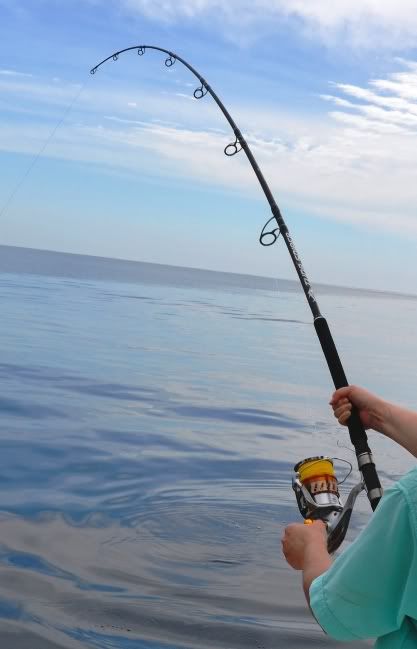
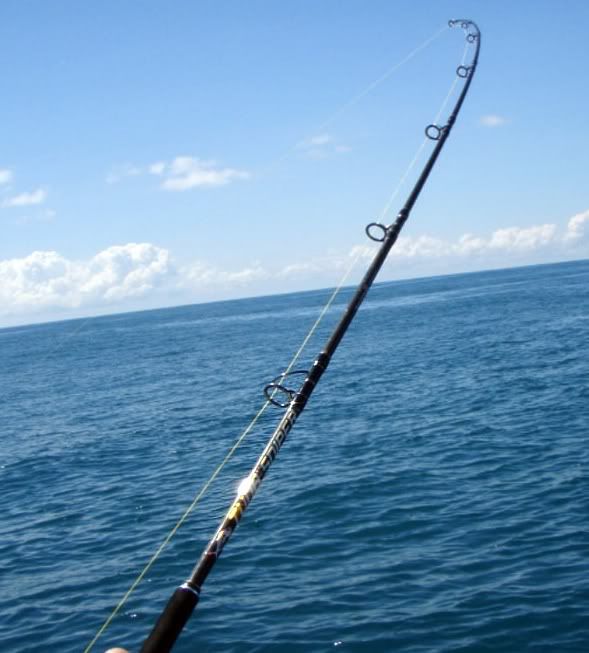
Black Devil 200 in action on large Tuna
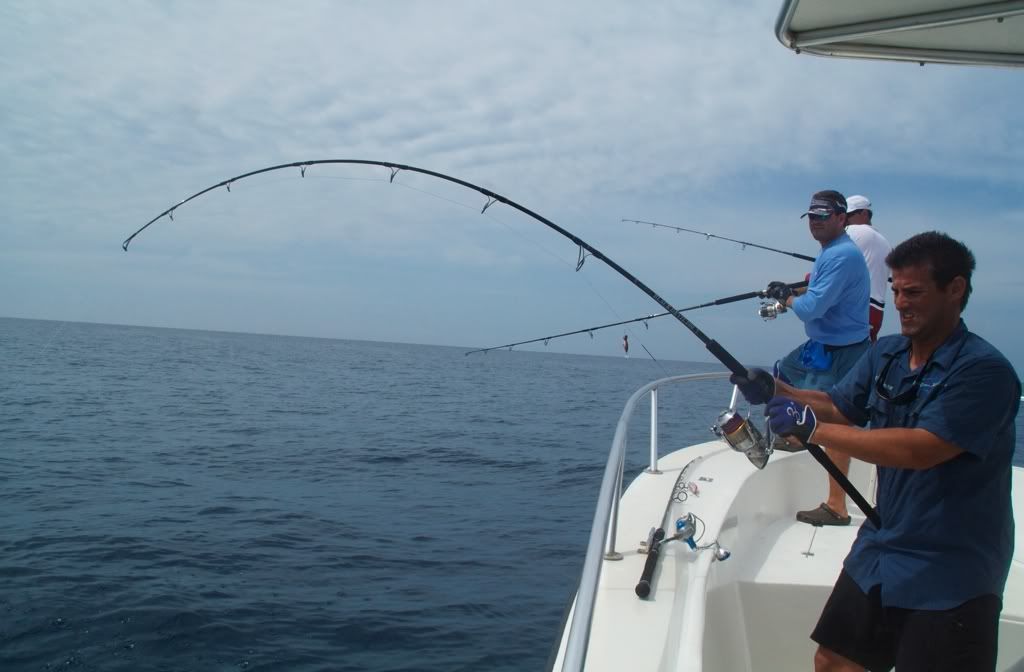
Black Devil 100 in Action
Gram rating: Casting rods will have a range of weighted lures to use
EXAMPLE: Rods with a 50-100g rating means the rod was made to throw a lure in the 50-100 gram range. This takes into consideration the ability to properly load the rod while casting. Under this example on a 50-100g rod you should not use a 160g lure, as it will not throw correctly.
PE rating: The PE rating is the same for both jigging and popping. Almost always a heavier gram rated rod will have a heavier PE line rating which translates into a higher drag capacity. You will be able to apply much more drag on a PE8 rod than a PE3 rod.
Drag Rating: Casting rods are longer therefore you have more of a chance of mis using rod therefore most manufactures will list a fighting drag and max drag rating to let you know the rods limits under load. It is advisable to stick within the ratings for successful use.
DO NOT HIGH STICK RODS or YOU WILL BREAK THEM
Personally I will only use PE6-8 rods because I know my popper size is 200-400g and my drag will always be high because of the fish I pursue
TOP SHELF CASTING RODS in no specific order prices range from $400 and up
**POPPER ROD FIRST, SWIM BAIT ROD SECOND based on PRICE**
Carpenter 78UHL, Carpenter TN-87
Ocean Revolution BLACK DEVIL 100, 200 & Stealth
HOTS Gipang 79XH, HOTS Gipang 83H
Smith WRC 80P/35, TOKARA 60
Zenaq Fooketo Trevally 83-5, Zenaq Fooketo Tuna 83-4
Ocean Tackle International Tuna Sniper 40/60, 60/80
Second Tier – great rods up to $250
OTI Ocean X-Treme Popping rods 40/60, 60/80
Lamiglass Tropic Pro 70/30
OTI Tuna Sniper in action


Black Devil 200 in action on large Tuna

Black Devil 100 in Action
Line & Leader
TIP Line – Never spool up your casting reel to the rim, this will create wind knots from excess line. On casting reels always back away from the brim enough so your leader is Braid is still beneath the spool lip
Example of spool being filled properly

You do not need PE lines but they are very nice if you want to spend the money if not normal braid will work fine. Basically in a nutshell you have two types of braids. Normal braids and PE braids.
REGULAR BRAID - I would strongly suggest the use of Braid, there are, as you know many good choices, personally I have used and been happy with several non colored braids such as Suffix, Tufline XP and JB solid & Hollowcore. I am not a fan of using windon leaders with Spinning reels but some swear by it. I have had issues with power pro so I have shied away from it, plus I do not like a coated braid. These braids are all cost effective and can used with confidence.
POPULAR BRAID COMPANIES
Suffix
Tufline XP
JB Solid or Hollowcore
PE LINES – Unlike the intro to jigging, colored braid is not needed unless you are using a reel as double duty. A softer braid is highly recommended because it will cast farther. I have used Tufline XP, Suffix, Jerry Brown Hollowcore, Varivas GT Max and my suggestion of Varivas GT Max SMP. This line is very expensive but is the single best casting line I have ever used. Soft but strong like bull.
POPULAR PE COMPANIES
Varivas
YGK

Example of spool being filled properly

You do not need PE lines but they are very nice if you want to spend the money if not normal braid will work fine. Basically in a nutshell you have two types of braids. Normal braids and PE braids.
REGULAR BRAID - I would strongly suggest the use of Braid, there are, as you know many good choices, personally I have used and been happy with several non colored braids such as Suffix, Tufline XP and JB solid & Hollowcore. I am not a fan of using windon leaders with Spinning reels but some swear by it. I have had issues with power pro so I have shied away from it, plus I do not like a coated braid. These braids are all cost effective and can used with confidence.
POPULAR BRAID COMPANIES
Suffix
Tufline XP
JB Solid or Hollowcore
PE LINES – Unlike the intro to jigging, colored braid is not needed unless you are using a reel as double duty. A softer braid is highly recommended because it will cast farther. I have used Tufline XP, Suffix, Jerry Brown Hollowcore, Varivas GT Max and my suggestion of Varivas GT Max SMP. This line is very expensive but is the single best casting line I have ever used. Soft but strong like bull.
POPULAR PE COMPANIES
Varivas
YGK

Understanding PE Lines
They began with diameter, using a long-established numbering system that fits a small range of diameters into a number – for instance, a No. 4 Japanese line will be close to 0.35mm diameter, regardless of whether it’s braid, nylon, fluorocarbon or whatever. In gel-spun polyethylene braids, these Japanese numbers are commonly used from 0.6 (about 0.14mm) to 12 (about 0.7mm); and they’re usually prefixed with PE (for PolyEthylene), so now you’ll often see Japanese braids referred to as PE1, or PE4, or PE8 or whatever.
One of the most noticeable differences is the line is completely soft and limp and non coated therefore it is very easy to tie a knot into
AVERAGE PE RATINGS – FOR TUNA I WILL USE PE6 - 80# AND UP
PE3- 40
PE4-55
PE5 - 70
PE6 – 80
PE8 – 100
PE10 – 120
PE12 - 150
POPULAR PE LINES
Varias Casting Line
YGK Casting line
One of the most noticeable differences is the line is completely soft and limp and non coated therefore it is very easy to tie a knot into
AVERAGE PE RATINGS – FOR TUNA I WILL USE PE6 - 80# AND UP
PE3- 40
PE4-55
PE5 - 70
PE6 – 80
PE8 – 100
PE10 – 120
PE12 - 150
POPULAR PE LINES
Varias Casting Line
YGK Casting line
Casting Leaders
TIP: You do not need Fluro Carbon Leader IMHO. When you are casting a popper your leader is being pulled through the water surface so the fish don’t really see it similar to trolling. If you are using a swim bait like a Smith Baby Runboh then maybe but 99% of the time I use regular shock leader.
Now the important factor here is to use SOFT leader so its casts correctly which is another reason I do not suggest Fluro as it tends to be stiff which affects the movement of your lure and your casting distance. Regular shock leader, which is a very soft subtle leader, which has very elastic properties and is extremely easy to tie knots with up to 240-pound test.
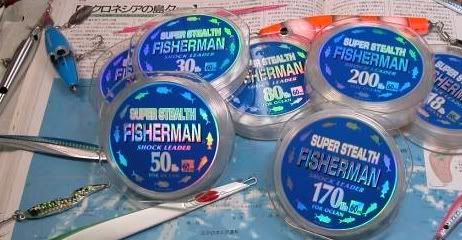
IMHO Proper Leader length is several wraps around spool and then back out of rod tip atleast 24-36" example below. Notice how popper ends up being between first and second guides.

I will start with length, I normally put about 4-6 wraps around my spool and then out of my rod tip by 2’ so maybe 15-20’ of leader. Just enough that if I get bit off several times I still wont have to re tie
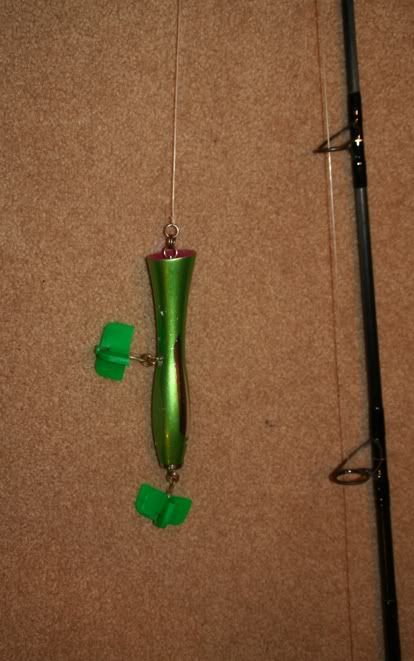
POPULAR SHOCK LEADERS
Varivas Shock Leader
Fisherman Stealth Leader
POPULAR FLUROCARBON
Blackwater
Yozuri
Seagar
Varivas
Now the important factor here is to use SOFT leader so its casts correctly which is another reason I do not suggest Fluro as it tends to be stiff which affects the movement of your lure and your casting distance. Regular shock leader, which is a very soft subtle leader, which has very elastic properties and is extremely easy to tie knots with up to 240-pound test.

IMHO Proper Leader length is several wraps around spool and then back out of rod tip atleast 24-36" example below. Notice how popper ends up being between first and second guides.

I will start with length, I normally put about 4-6 wraps around my spool and then out of my rod tip by 2’ so maybe 15-20’ of leader. Just enough that if I get bit off several times I still wont have to re tie

POPULAR SHOCK LEADERS
Varivas Shock Leader
Fisherman Stealth Leader
POPULAR FLUROCARBON
Blackwater
Yozuri
Seagar
Varivas
TIP – Whatever knot you decide to use make sure it is short and slim, you are casting therefore the knot must pass through 8’ of casting rod. Super short and slim. If you are doing a Page Ranking Knot you should make it half the size as your normal one so it does not get caught up in guides during casting 1.5 - 2” max
There is no perfect answer here but many choices as I tell everyone the best knot to tie is a knot you are comfortable tying. Period end of story. Some love the uni-uni, some love the Albright, some like the midknot, personally I use a Page Ranking knot because of it low profile and strength
But there are many knots that will work. Another connections would be wind on leader, which is gaining in popularity. This loop-to-loop connection is very easy to make and has no knot at all
BHP Tackle - Wind-On Leaders - Topshots - Fluorocarbon Wind-On Leaders - Hollow Spectra
There is no perfect answer here but many choices as I tell everyone the best knot to tie is a knot you are comfortable tying. Period end of story. Some love the uni-uni, some love the Albright, some like the midknot, personally I use a Page Ranking knot because of it low profile and strength
But there are many knots that will work. Another connections would be wind on leader, which is gaining in popularity. This loop-to-loop connection is very easy to make and has no knot at all
BHP Tackle - Wind-On Leaders - Topshots - Fluorocarbon Wind-On Leaders - Hollow Spectra
Connections to Popper
TIP: You should use extra large split rings to accommodate larger hooks and the depth of popper cup if not you will not have clearance
Any knot will work like a uni, trilene etc. You have two major ways of connecting your leader to your jigs after your knot. As you know it can become very time consuming to re tie while the bite is hot so most incorporate a very simple connection.
WHEN YOU WANT TO CHANGE POPPERS
The benefit to these connections is you never need to re tie you just take the popper off the split ring to change out with the split ring pliers. Simple and easy and quick to do.
1. Swivel to split ring to popper - Personally this is the way I connect everything. As you are casting your line as a tendency to twist because of the motion and as you know line twist can leader to damaged or weekend line so I always use a swivel. It’s the safest way to prolong the life of your line.
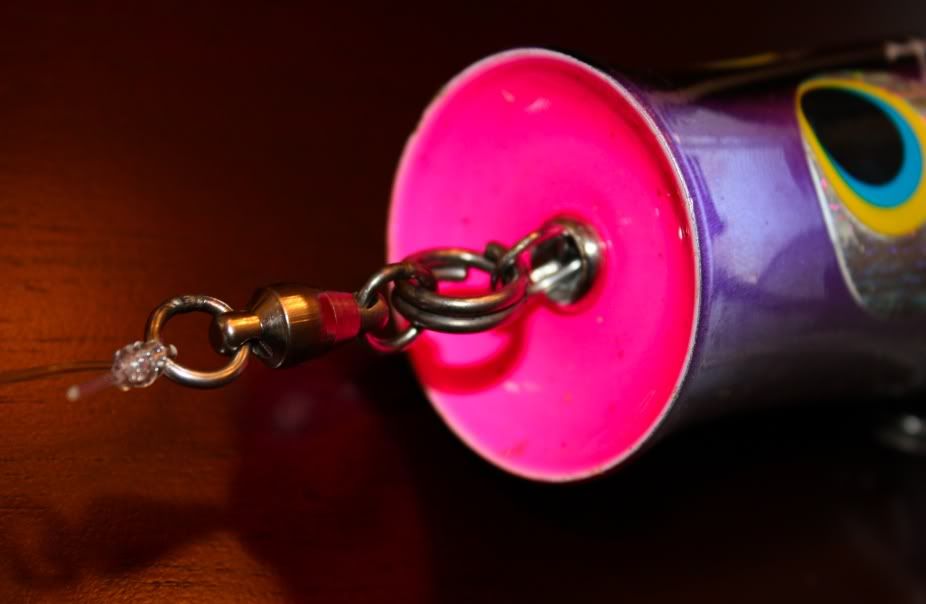
TOOLS NEEDED
Owner 200-300 pound swivels and split rings from 400# and up.
Any knot will work like a uni, trilene etc. You have two major ways of connecting your leader to your jigs after your knot. As you know it can become very time consuming to re tie while the bite is hot so most incorporate a very simple connection.
WHEN YOU WANT TO CHANGE POPPERS
The benefit to these connections is you never need to re tie you just take the popper off the split ring to change out with the split ring pliers. Simple and easy and quick to do.
1. Swivel to split ring to popper - Personally this is the way I connect everything. As you are casting your line as a tendency to twist because of the motion and as you know line twist can leader to damaged or weekend line so I always use a swivel. It’s the safest way to prolong the life of your line.

TOOLS NEEDED
Owner 200-300 pound swivels and split rings from 400# and up.
Types of Lures
TIP - Always carry a variety of lures from small to large so you can try to match the size of the bait being pursued not necessarily the color. When casting to Tuna I will carry an assortment of lures from 1” metals to 10” long poppers and stick baits. You will have two very different types of lures to throw at your fish
SURFACE OR SUBSURFACE
Both can be deadly under the right circumstances and both will drive fish absolutely mad. Generally if I’m not seeing fish I will throw poppers or if I’m fishing underwater structure I will throw poppers. If I see fish I will throw subsurface for the most part unless they aren’t interested then I will switch and sometimes it’s the opposite but that’s my initial thought process
TOP- Surface Popper
Middle - Surface Stickbait
Bottom Subsurface Swimbait
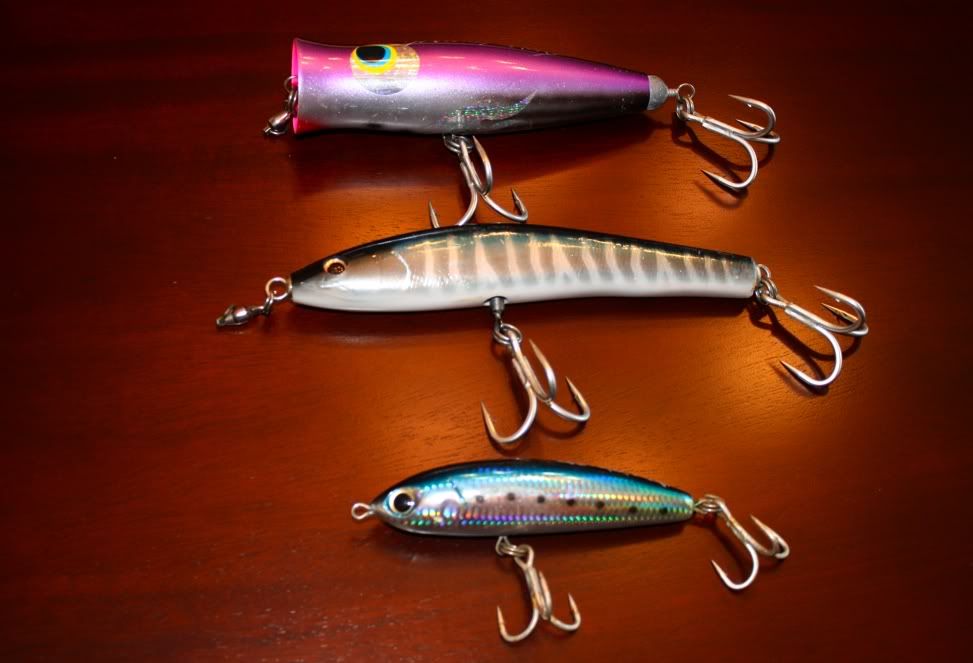
Front view
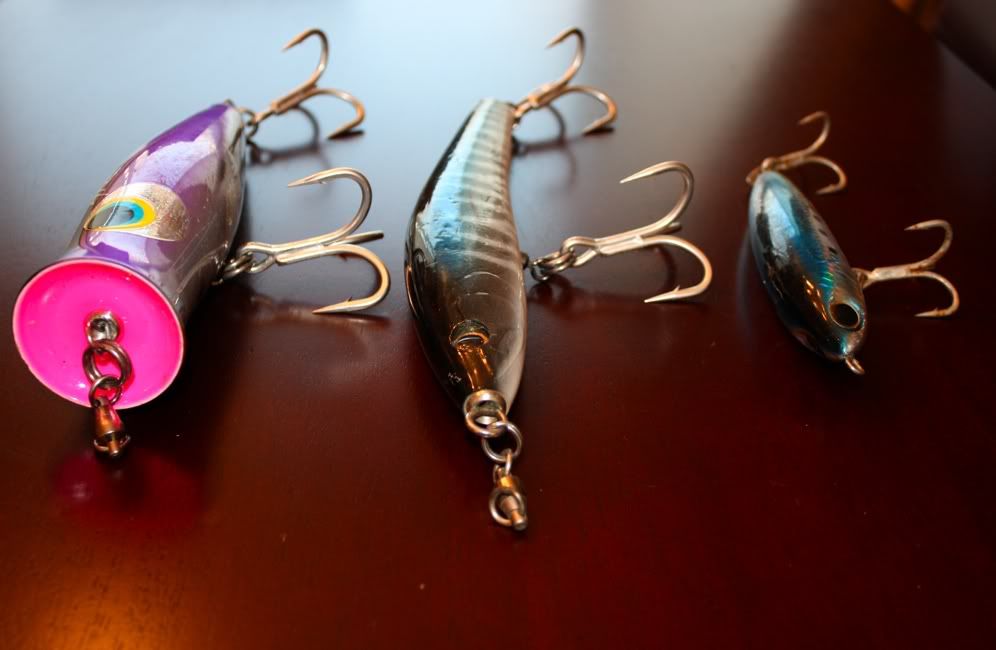
SURFACE OR SUBSURFACE
Both can be deadly under the right circumstances and both will drive fish absolutely mad. Generally if I’m not seeing fish I will throw poppers or if I’m fishing underwater structure I will throw poppers. If I see fish I will throw subsurface for the most part unless they aren’t interested then I will switch and sometimes it’s the opposite but that’s my initial thought process
TOP- Surface Popper
Middle - Surface Stickbait
Bottom Subsurface Swimbait

Front view

Surface Lures - Poppers
Poppers: This 3”- 15” lure has a cupped face and is made to “POP” & throw water, when pulled correctly you should be able to chug massive amounts of water. They attract fish upwards towards the surface. These lures are effective in any type of water whether it is flat seas, big swells or choppy conditions. Poppers are extremely effective when fishing for GT’s, Cubera Snappers or Rooster Fish that generally hang around rocky structures below the surface. The chug will pull them up in an attacking fashion and the strike will be Violent. They are also deadly for massive tunas … the larger the chug the bigger the fish IMHO.
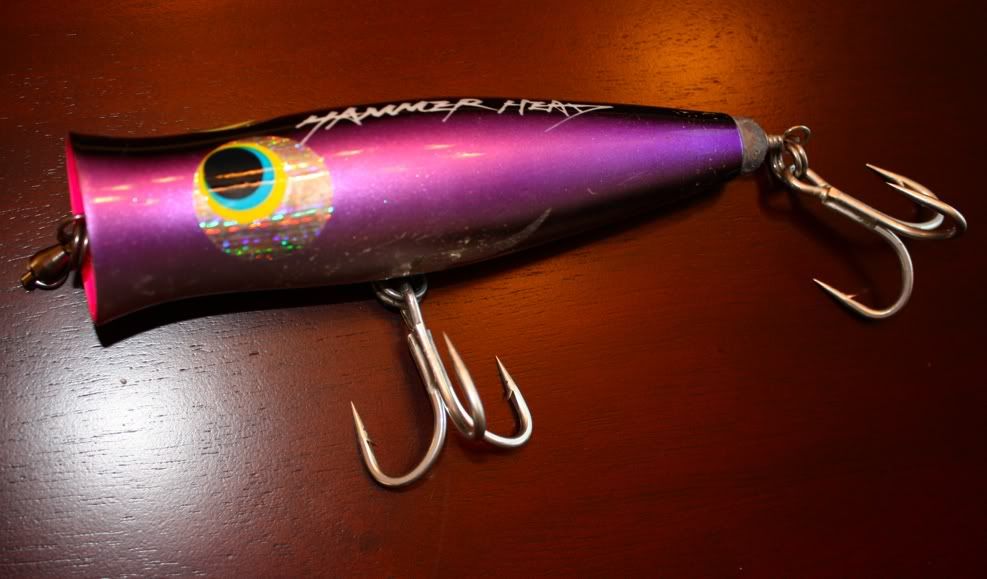
HOW TO CHOOSE A POPPER: Generally I look for a deep wide cup face this will displace the most amount of water with the least amount of effort. I also look for a great finish and vibrant colors. I also look for a wood construction with adequate through wire construction. Cypress wood holds up the best while foam injected poppers tend to break consistently near the narrow part of the neck
Example of cup face, the deeper or wider the cup the larger the splash
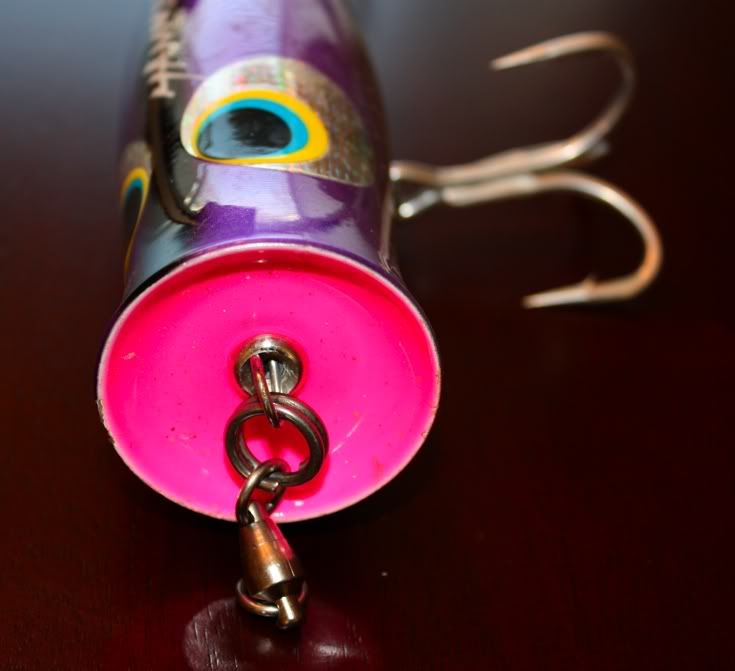
COLORS: Personally while throwing poppers in light or clear waters I tend to use BLACK as it is a nice silohette on eth waters surface. In darker waters like Mexico or Panama I tend o use brighter colors like PINK, PURPLE and YELLOW.
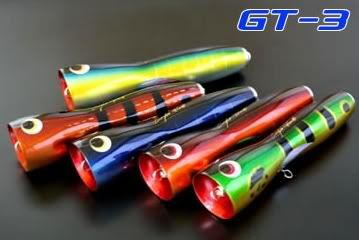
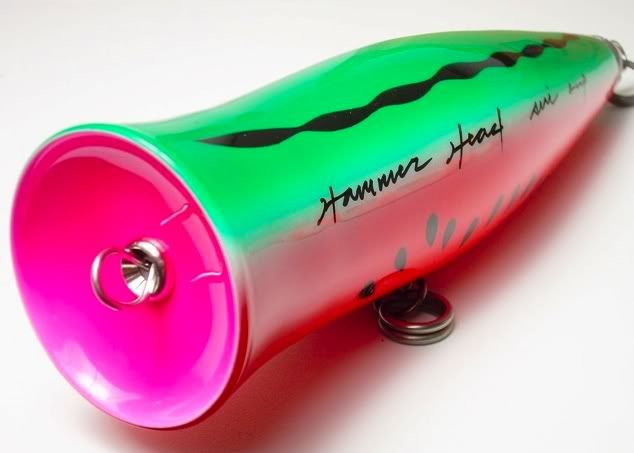

HOW TO CHOOSE A POPPER: Generally I look for a deep wide cup face this will displace the most amount of water with the least amount of effort. I also look for a great finish and vibrant colors. I also look for a wood construction with adequate through wire construction. Cypress wood holds up the best while foam injected poppers tend to break consistently near the narrow part of the neck
Example of cup face, the deeper or wider the cup the larger the splash

COLORS: Personally while throwing poppers in light or clear waters I tend to use BLACK as it is a nice silohette on eth waters surface. In darker waters like Mexico or Panama I tend o use brighter colors like PINK, PURPLE and YELLOW.


Surface Lures - Stick Baits
Stick bait’s – Stick bait’s are similar in size to a popper and similar design BUT lack the cup in the front, instead most have an angled nose which makes the lure dip and thrash from side to side like an injured bait fish. These are extremely effective as well and should be in any tackle bag. They are normally floating and longer than most poppers.
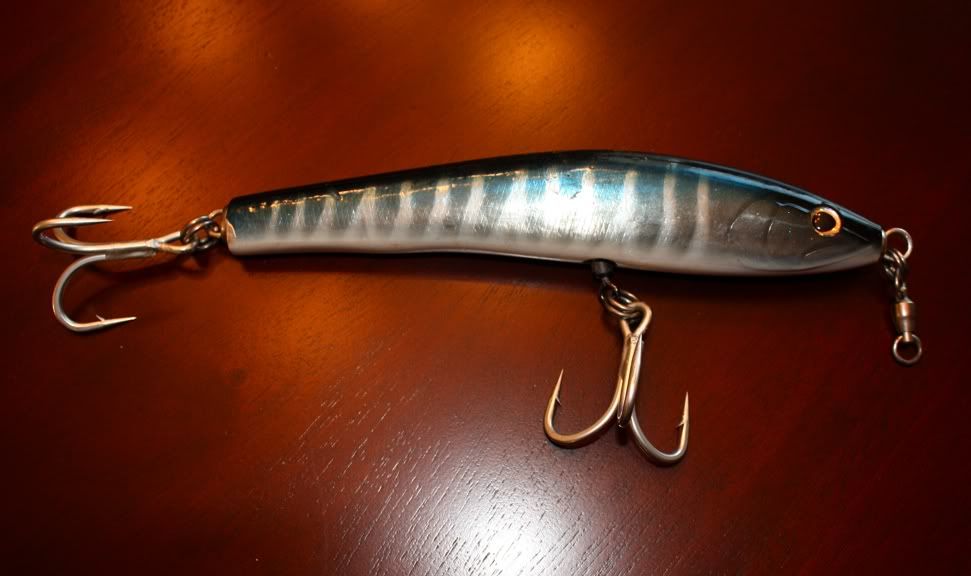
HOW TO CHOOSE A STICKBAIT: Generally I choose an angled nose stickbait because this shape tends to make the most commotion while fatter stickbaits like the Squid Pen tend to make more of a darting wobble effect. Depending on how it is weighted also depicts the action.
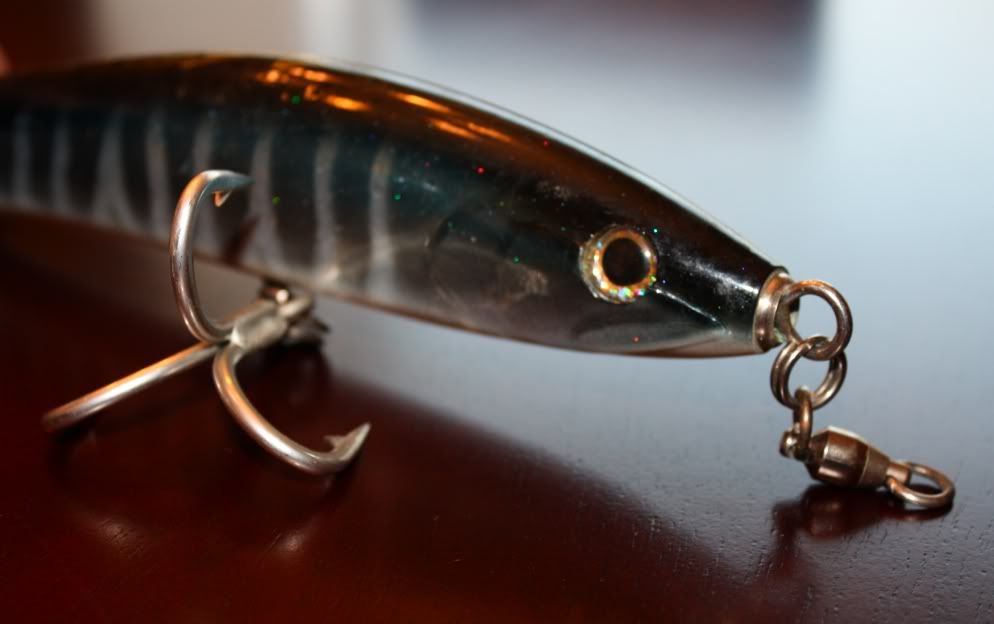
COLORS: Unlike poppers stickbaits are made to mimic real baitfish therefore I tend to like the longer models that are very similar to the local baitfish such as FLYING FISH & Sardine.
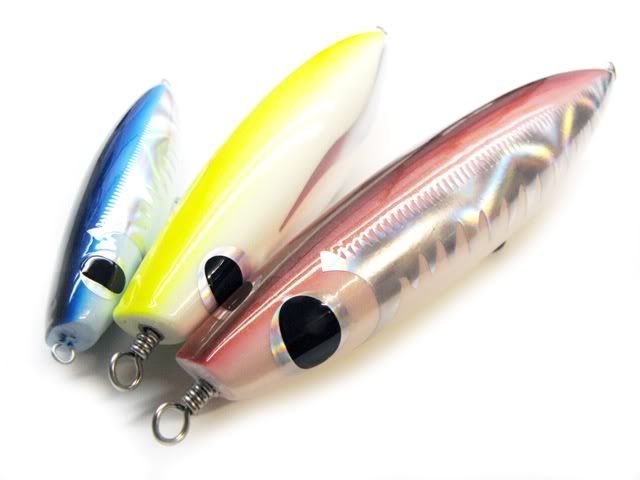

HOW TO CHOOSE A STICKBAIT: Generally I choose an angled nose stickbait because this shape tends to make the most commotion while fatter stickbaits like the Squid Pen tend to make more of a darting wobble effect. Depending on how it is weighted also depicts the action.

COLORS: Unlike poppers stickbaits are made to mimic real baitfish therefore I tend to like the longer models that are very similar to the local baitfish such as FLYING FISH & Sardine.

Manufactures
HIGH END Lures from $40-90.00 dollars
Hammerhead I Cup & G Cup
Craftbait GT2, GT3 and GT3 Ultra
Fisherman Brand Big Mouth
Skagit Pump King
Mangrove Studio
Nomad Poppers
CRAFTBAIT IN ACTION
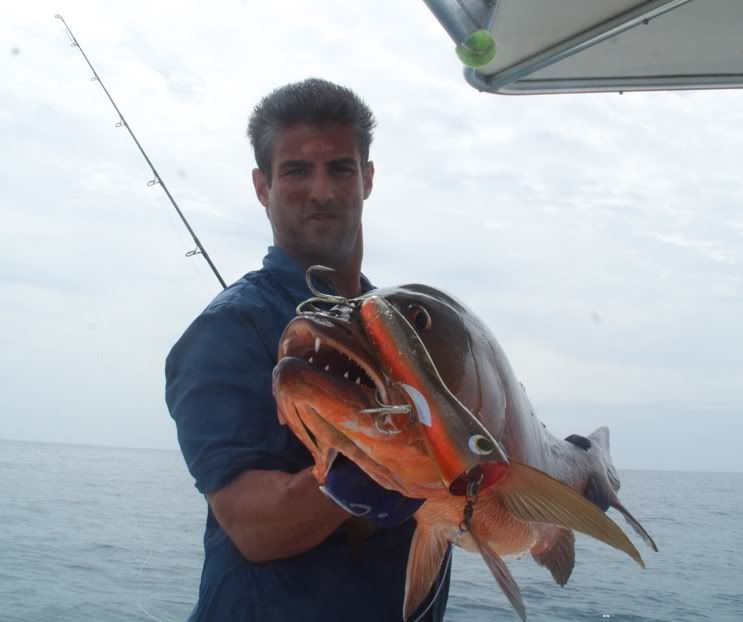
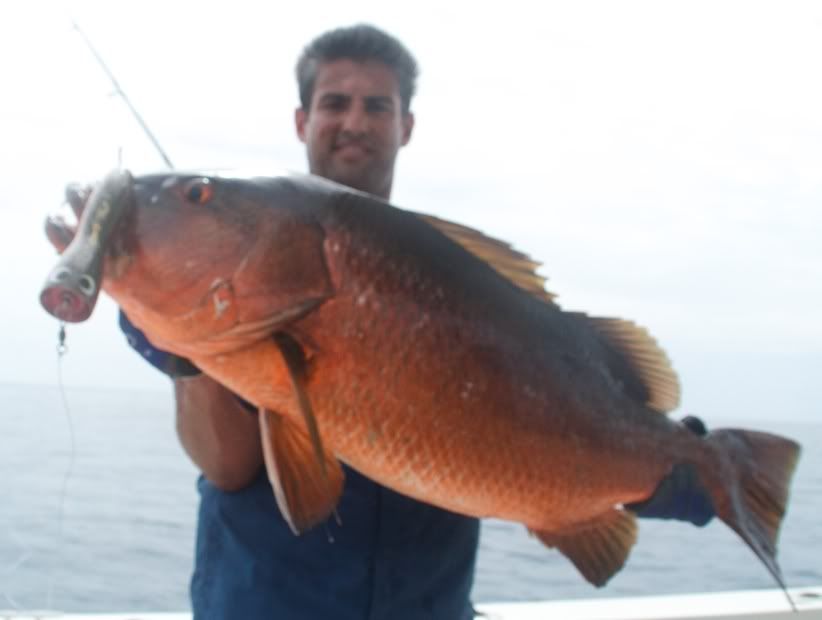
SKAGIT PUMP KING IN ACTION
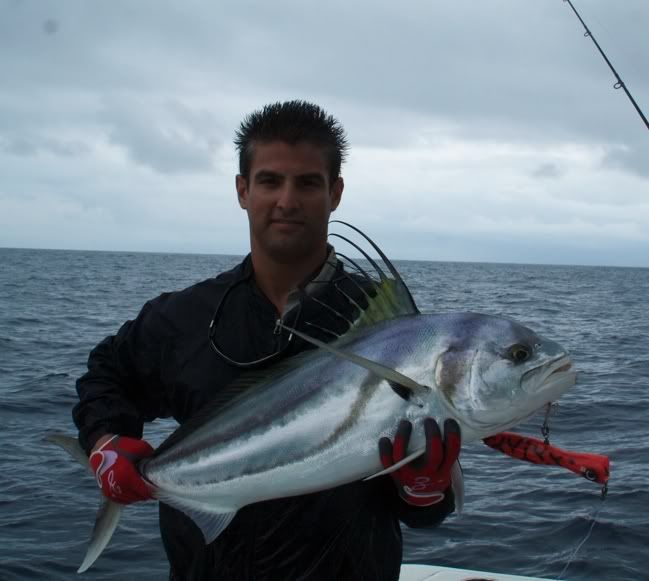
MID RANGED LURES UNDER $40.00
Page Ranking Labs Joker, Back Bone, Fly, Bone Eater
FCL Labo EBI Pop
Ocean Tackle International Komodo, Goanna & Wombat
Strike Pro Tuna Hunter
Yozuri Surface Bull
River2Sea Dumbell
FCL LABO IN ACTION

Heru Poppers in action
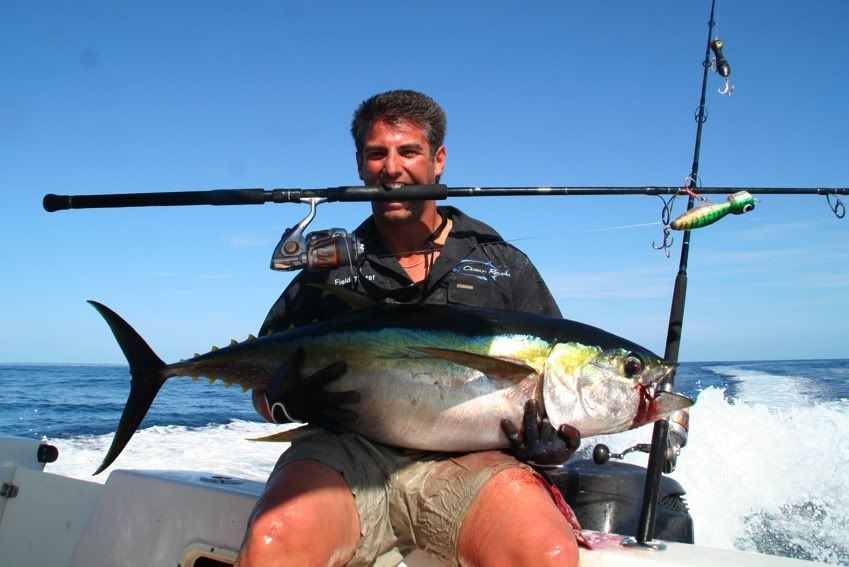
OTI in Action

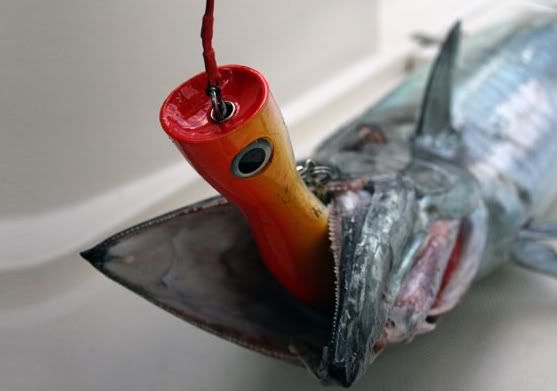
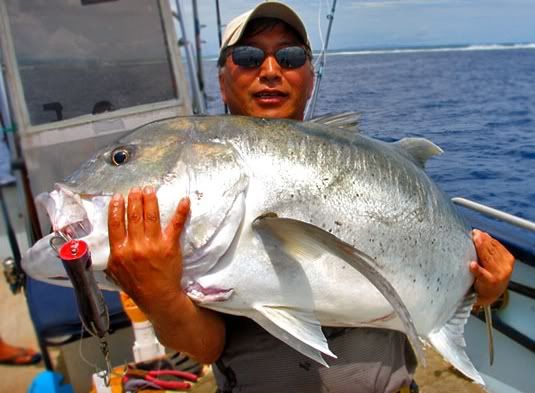
Hammerhead I Cup & G Cup
Craftbait GT2, GT3 and GT3 Ultra
Fisherman Brand Big Mouth
Skagit Pump King
Mangrove Studio
Nomad Poppers
CRAFTBAIT IN ACTION


SKAGIT PUMP KING IN ACTION

MID RANGED LURES UNDER $40.00
Page Ranking Labs Joker, Back Bone, Fly, Bone Eater
FCL Labo EBI Pop
Ocean Tackle International Komodo, Goanna & Wombat
Strike Pro Tuna Hunter
Yozuri Surface Bull
River2Sea Dumbell
FCL LABO IN ACTION

Heru Poppers in action

OTI in Action



Presentation of Poppers/stickbaits
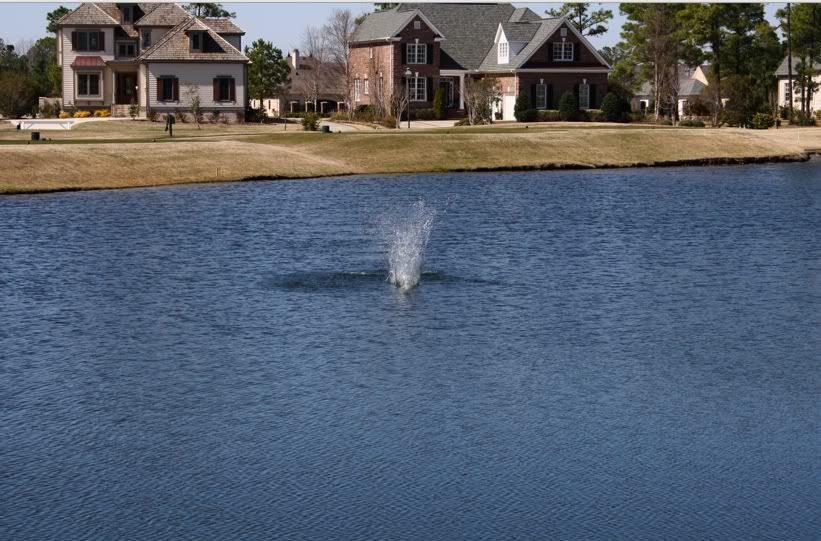
You are trying to mimic baitfish busting on the waters surface therefore the bigger the splash the better, in order to accomplish this you can use two techniques or a combo of the two
1. Slower Technique - Rod tip down after cast and pull violently towards the waters surface with a pause every once in a while. You know that you are doing this right when you actually here the popper digging into the surface causing a very loud noise
2. Faster Technique – with the rod tip up you can chug faster mimicking a baitfish being chased, pull, reel, pull, reel. One rotation per cycle with an occasional pause so do this with the rod tip up and a faster pace or you can combine the two techniques
Really funny video of us bored when we were blown out last weekend full of casting it HQ for better resolution
Subsurface Lures - Swimbaits
These lures are absolutely deadly and can make the difference between a skunk and a massive slob fish on the deck. Honestly these are the first out of my bag and the Smith Baby Runboh is the deadliest tuna lure I know. Period end of story
DON’T HAVE A HEART ATTACK … they are expensive but worth every figgin penny.
SOULS BARABUS IN ACTION

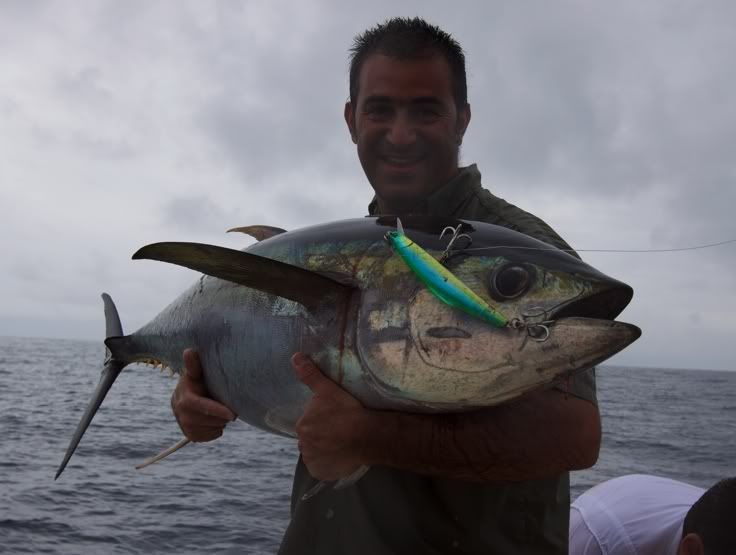
VOLADOR IN ACTION
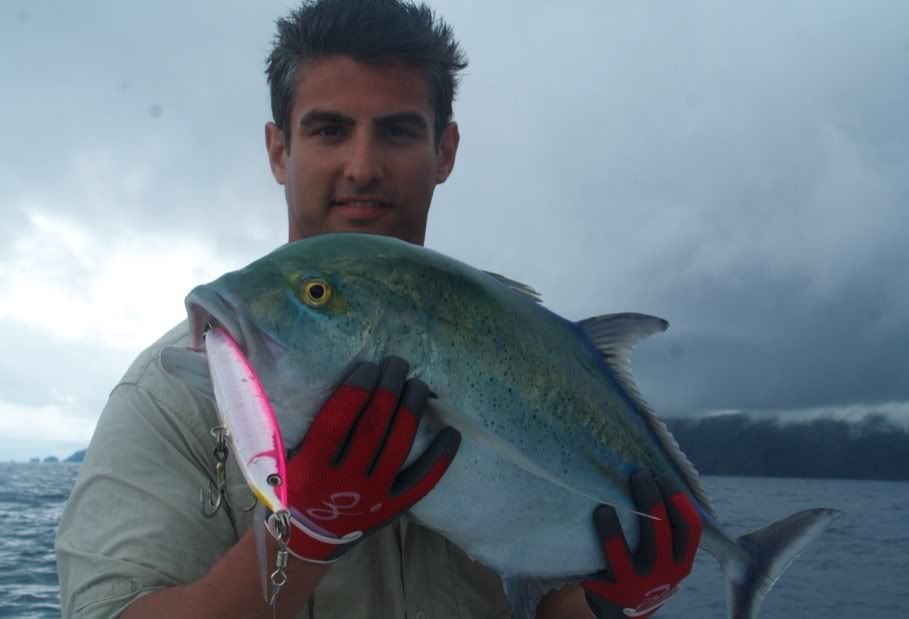
The subsurface lures are all flash, dash and wiggle. They imitate baitfish under the surface. They are generally smaller in size about 5” long and shaped like a baitfish generall most effective when a pause or a twitch is added to presentation.
Popular swim baits …. Absolutely deadly. In order my top list
1. SMITH Baby Runboh – first lure out of my bag no doubt about it
2. Tackle House Shibuki or Souls Barabus – same lure although Souls is slightly heavier
3. Shimano Ocea Pencil – Badass lure that produces big fish
4. Tailwalk Gunz – Newer lure that has shown to be effective with brilliant colors
PRESENTATION
After cast you should let the lures sink for at least a 5-10 count depending on where the fish are located, then use one of the following techniques
1. Rod tip down - Long sweep motion across body … reel slack , long sweeping motion across body … reel slack and Pause then repeat process. This will imitate a squid to perfection as they have long burst followed by a pause
2.Rod tip up or down - Slow steady retrieve with a periodic twitch and pause, then repeat motion back to boat
DON’T HAVE A HEART ATTACK … they are expensive but worth every figgin penny.
SOULS BARABUS IN ACTION


VOLADOR IN ACTION

The subsurface lures are all flash, dash and wiggle. They imitate baitfish under the surface. They are generally smaller in size about 5” long and shaped like a baitfish generall most effective when a pause or a twitch is added to presentation.
Popular swim baits …. Absolutely deadly. In order my top list
1. SMITH Baby Runboh – first lure out of my bag no doubt about it
2. Tackle House Shibuki or Souls Barabus – same lure although Souls is slightly heavier
3. Shimano Ocea Pencil – Badass lure that produces big fish
4. Tailwalk Gunz – Newer lure that has shown to be effective with brilliant colors
PRESENTATION
After cast you should let the lures sink for at least a 5-10 count depending on where the fish are located, then use one of the following techniques
1. Rod tip down - Long sweep motion across body … reel slack , long sweeping motion across body … reel slack and Pause then repeat process. This will imitate a squid to perfection as they have long burst followed by a pause
2.Rod tip up or down - Slow steady retrieve with a periodic twitch and pause, then repeat motion back to boat
Hooks
TIP: ALWAYS GO BIG & REINFORCED .....
Tuna and Pelagic Fish with Poppers & Stick baits
1. Generally you need to use heavy, heavy treble hooks the larger the better. I strongly suggest the use 5/0 Owner ST-76. The only hooks I will use. They are super strong and unlike the ST-66 I haven’t heard of any opening or being straightened.
4/0 ST66 ON LEFT versus 4/0 ST76 ON RIGHT

2. Using a Heavy larger treble hook on belly and then a large single on tail, I have fished with people that swear by using a single trailing hook. The jury is out and I have had mixed feelings on the subject. For meat fish I like using double 5/0 treble but this is another option
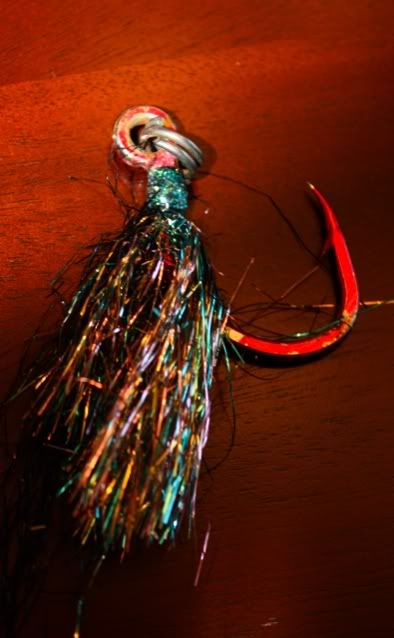

Tuna and Pelagic Fish with Swim Baits
Swim baits are much smaller and they swim hence the name swim baits therefore it is very important not to change there motion. I would strongly suggest using a size 3/0 Owner ST-76, there is enough of a hook to catch flesh but not screw up its motion
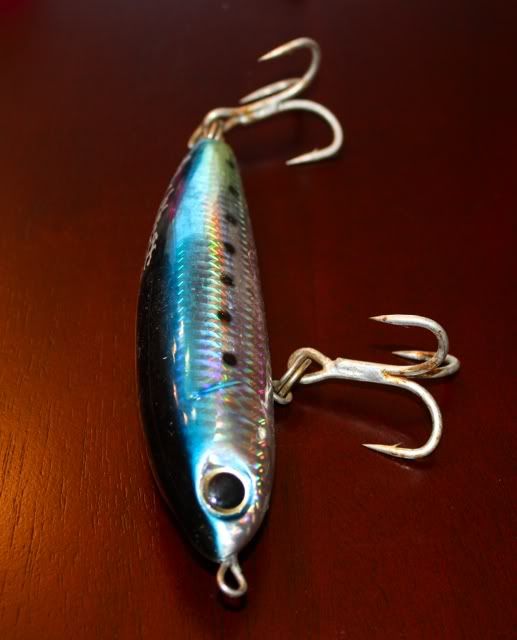
Marlin & Billfish
Most people do not understand that Marlin & Sailfish are very attracted to poppers and swim baits. While in Cabo I successfully caught & released Striped Marlin on poppers and then in Panama two large Sailfish were also released.
Idealy you want to sightfish for tailing Marlin then cast in front of them or troll live hookless baits and then as fish enter spread toss them a popper similiar to bait and switch mode when fly fishing
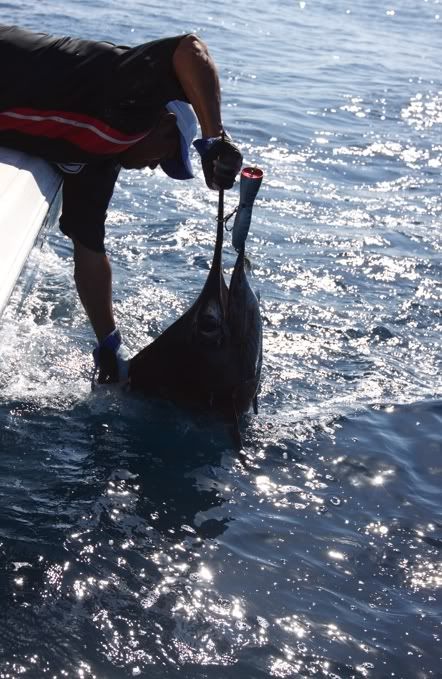
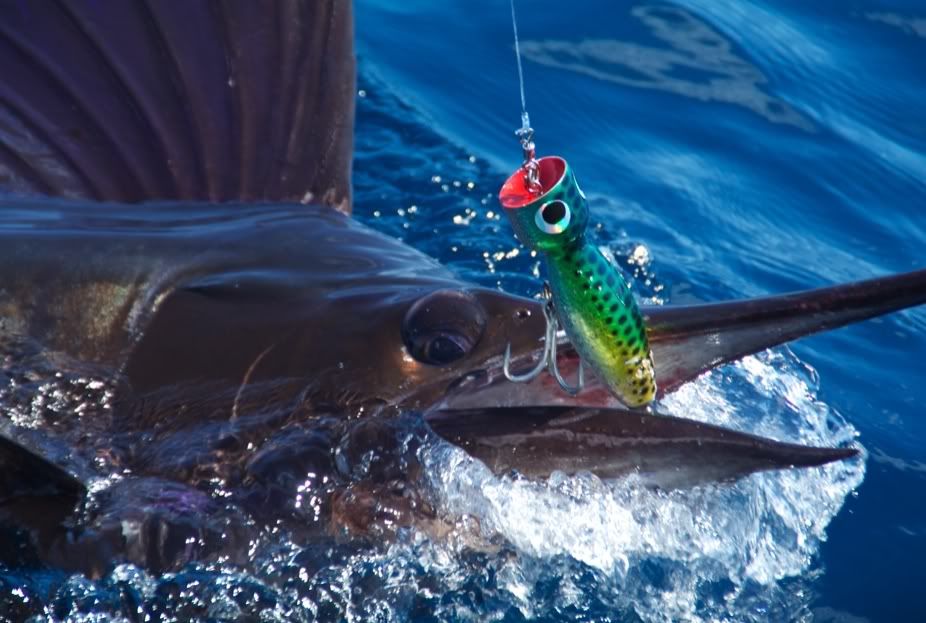
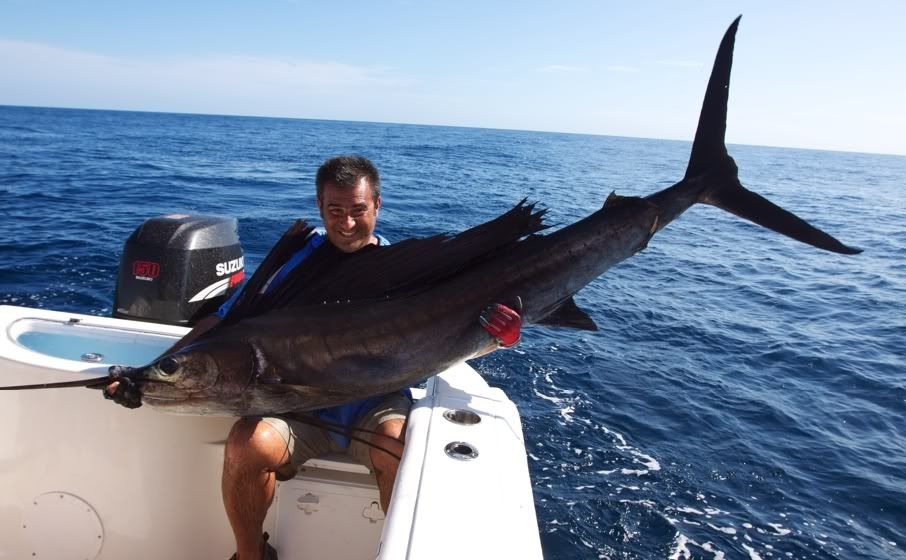
I will only use single hooks and would only suggest you do the same so release is easier and you do the least amount of damage to the fish. You can rig the popper, stick bait or swim bait with the single attached through the split ring or you can tie assist hooks with Kevlar and attach that way as well
*** Please note if you are casting to Marlin, make sure you let them eat for a 3 count before setting the hook so the swinging hook gets lodged in the mouth. You can use any large single like a Jobu or a Varivas
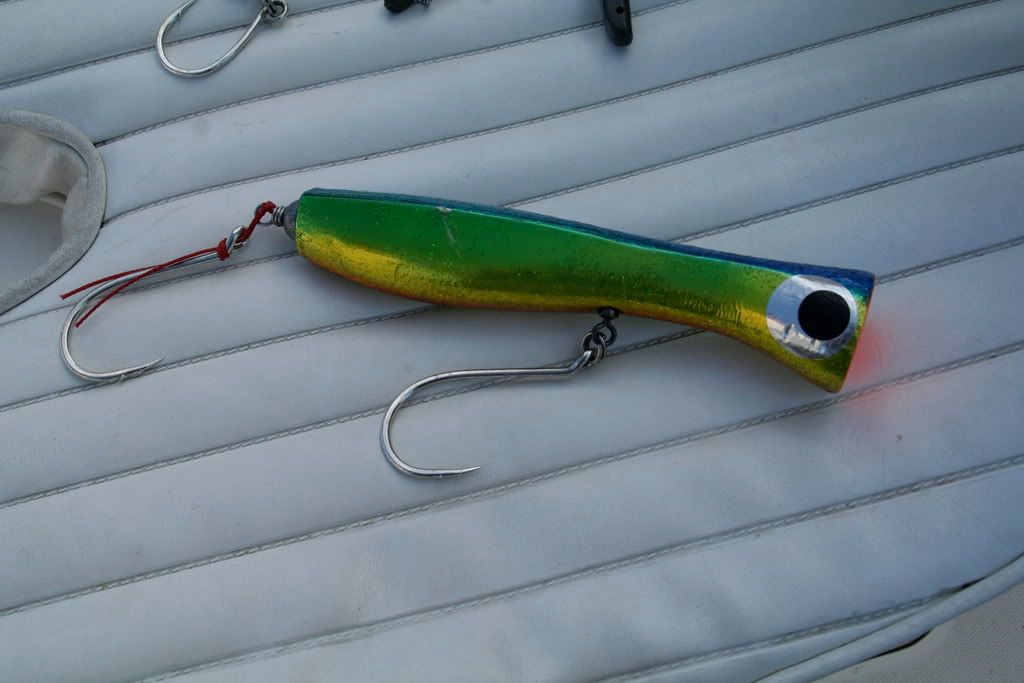
Striped Marlin of Cabo San Lucas with Mangrove studio popper with dual single hooks
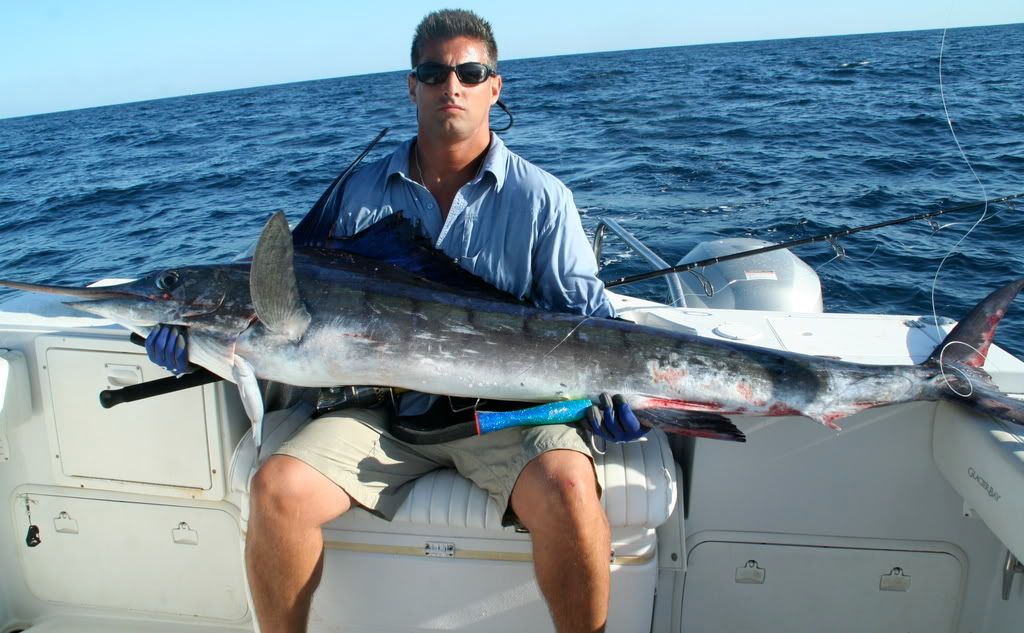
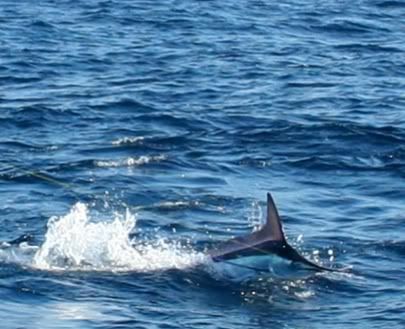
Tuna and Pelagic Fish with Poppers & Stick baits
1. Generally you need to use heavy, heavy treble hooks the larger the better. I strongly suggest the use 5/0 Owner ST-76. The only hooks I will use. They are super strong and unlike the ST-66 I haven’t heard of any opening or being straightened.
4/0 ST66 ON LEFT versus 4/0 ST76 ON RIGHT

2. Using a Heavy larger treble hook on belly and then a large single on tail, I have fished with people that swear by using a single trailing hook. The jury is out and I have had mixed feelings on the subject. For meat fish I like using double 5/0 treble but this is another option


Tuna and Pelagic Fish with Swim Baits
Swim baits are much smaller and they swim hence the name swim baits therefore it is very important not to change there motion. I would strongly suggest using a size 3/0 Owner ST-76, there is enough of a hook to catch flesh but not screw up its motion

Marlin & Billfish
Most people do not understand that Marlin & Sailfish are very attracted to poppers and swim baits. While in Cabo I successfully caught & released Striped Marlin on poppers and then in Panama two large Sailfish were also released.
Idealy you want to sightfish for tailing Marlin then cast in front of them or troll live hookless baits and then as fish enter spread toss them a popper similiar to bait and switch mode when fly fishing



I will only use single hooks and would only suggest you do the same so release is easier and you do the least amount of damage to the fish. You can rig the popper, stick bait or swim bait with the single attached through the split ring or you can tie assist hooks with Kevlar and attach that way as well
*** Please note if you are casting to Marlin, make sure you let them eat for a 3 count before setting the hook so the swinging hook gets lodged in the mouth. You can use any large single like a Jobu or a Varivas

Striped Marlin of Cabo San Lucas with Mangrove studio popper with dual single hooks


Casting technique
There are some keys to casting that will allow you to gain some additional yardage with some practice you should be able to throw a lure 80 plus yards without issue on a pitching boat.
The motion is very much like normal casting with some slight differences
GRIP: Personally I grip the reel between the ring and pinkie finger and then use my pointing finger to hold line while I flip bail

LEADER LENGTH: The longer your leader to popper connection is outside your rod the longer your cast should be. I keep my lure approximately 2-3 feet outside my rod tip this helps create velocity while casting.
NON REEL GRIP HAND – should be used to pull rod butt down while casting.
TIMING: Always cast WITH the pitching boat
Putting it all together, first I get the proper grip, good balanced stance, I flip my bail and hold line with my pointer finger. I leave my popper dangling approximately 2’ from the tip and over the side of the boat … I rock back with boat and in a strong compact movement I come forward with power ahead of my target.
This isn’t rocket scense but tricks like keeping your popper out far from rod tip and pulling down with opposite hand while casting will increase your distance. Here is a short video of me screwing around at a gold course lake last weekend the lake is about 80-100 yards wide in certain spots.
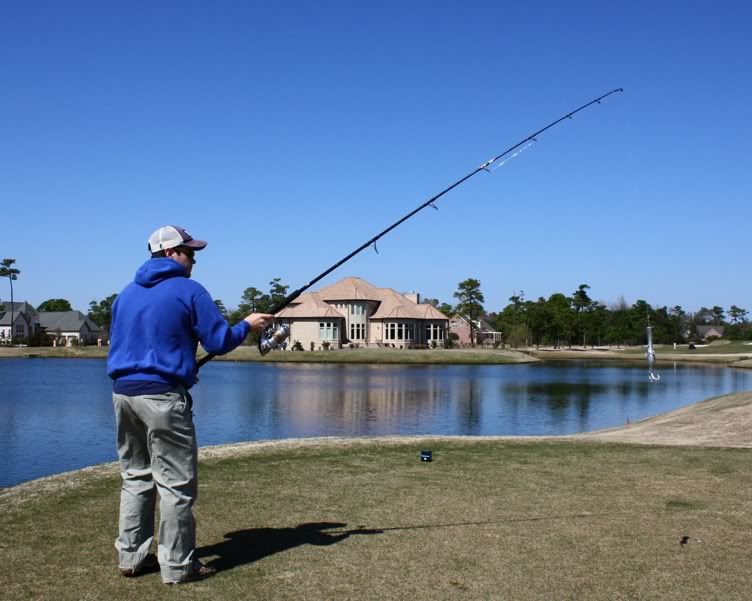


The motion is very much like normal casting with some slight differences
GRIP: Personally I grip the reel between the ring and pinkie finger and then use my pointing finger to hold line while I flip bail

LEADER LENGTH: The longer your leader to popper connection is outside your rod the longer your cast should be. I keep my lure approximately 2-3 feet outside my rod tip this helps create velocity while casting.
NON REEL GRIP HAND – should be used to pull rod butt down while casting.
TIMING: Always cast WITH the pitching boat
Putting it all together, first I get the proper grip, good balanced stance, I flip my bail and hold line with my pointer finger. I leave my popper dangling approximately 2’ from the tip and over the side of the boat … I rock back with boat and in a strong compact movement I come forward with power ahead of my target.
This isn’t rocket scense but tricks like keeping your popper out far from rod tip and pulling down with opposite hand while casting will increase your distance. Here is a short video of me screwing around at a gold course lake last weekend the lake is about 80-100 yards wide in certain spots.



Accessories
Gloves – In order to cast far you must load the rod, which means extreme stress will be put on your hands therefore gloves are basically Keep in mind when selecting a pair of gloves that you should get them tight fitting and find a pair that is light and has a protected finger. They come in every color. Hint of advice make sure you order a size larger if you are planning on buying an overseas brand, as they tend to run very small
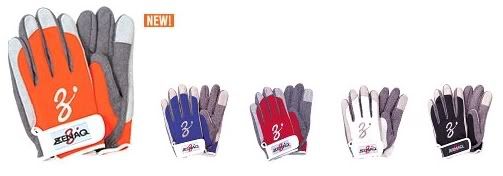
POPPING GLOVE COMPANIES
Zenaq
Smith
Fisherman Brand
Jigging Master
Ocean Revolution (in development)
Belts –Its important to use a low profile belt while casting so it doesn’t get in your way. Most of the Japanese jigging belts ride higher in waist but you can lower them personally I use a lower belt for leverage
SEVEN SEAS
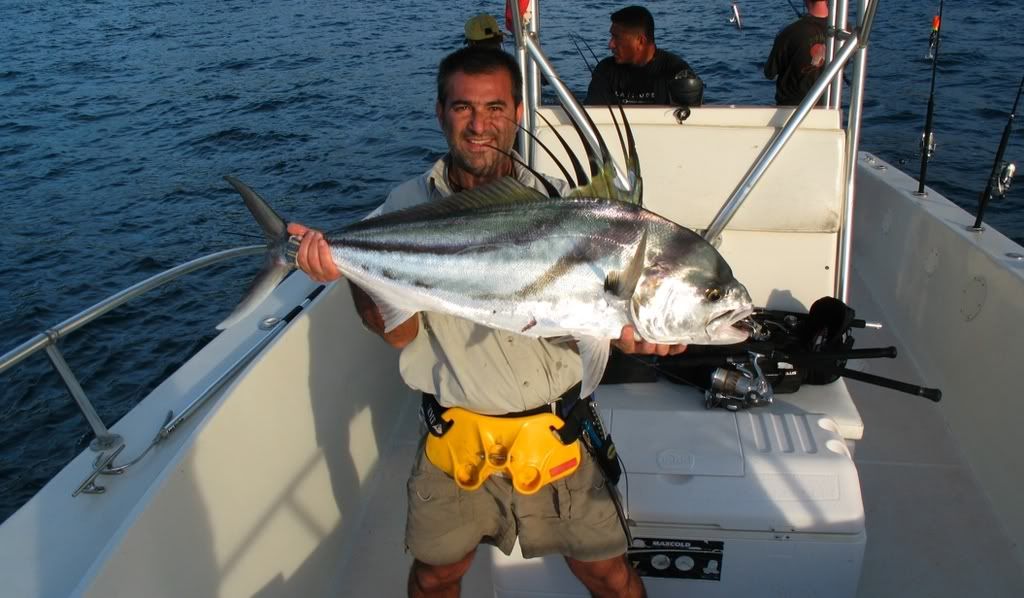
FISHERMANS FLAT BELT
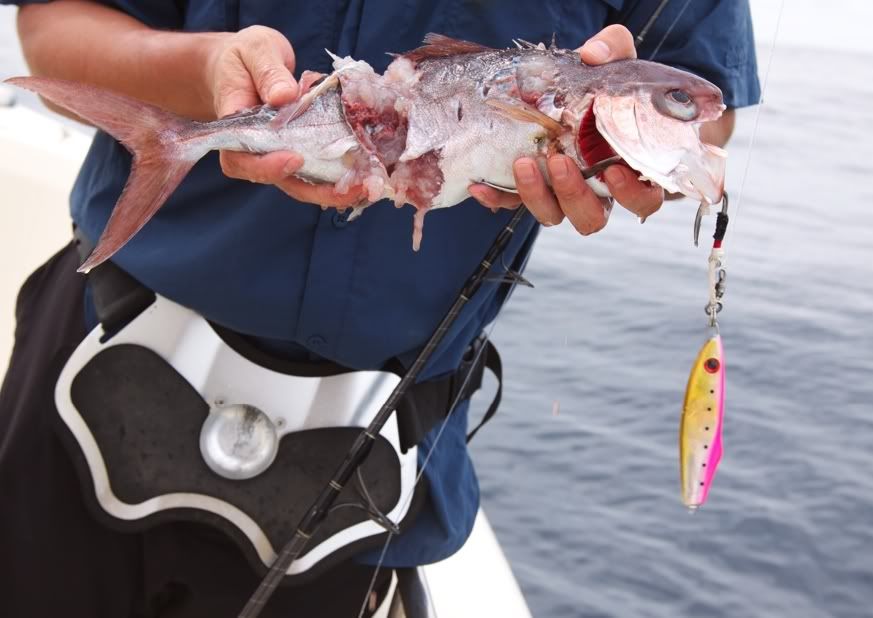
JIGGING BELT COMPANIES
Seven Seas
Fisherman Brand
Jigging Master
Hots
Ocean Revolution (in development)
Smittys
Split ring Pliers
Split ring Pliers will make your life easy and will also be able to serve duel purposes as in cutting braid, leader and changing poppers. I would strongly suggest keeping your pliers in a sheath on your fishing belt connected with some type of tether so you don’t lose them over board
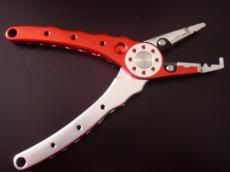
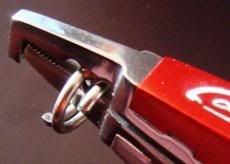
SPLIT RING PLIER COMPANIES
Duo
Duel
Fisherman
Ocean revolution

POPPING GLOVE COMPANIES
Zenaq
Smith
Fisherman Brand
Jigging Master
Ocean Revolution (in development)
Belts –Its important to use a low profile belt while casting so it doesn’t get in your way. Most of the Japanese jigging belts ride higher in waist but you can lower them personally I use a lower belt for leverage
SEVEN SEAS

FISHERMANS FLAT BELT

JIGGING BELT COMPANIES
Seven Seas
Fisherman Brand
Jigging Master
Hots
Ocean Revolution (in development)
Smittys
Split ring Pliers
Split ring Pliers will make your life easy and will also be able to serve duel purposes as in cutting braid, leader and changing poppers. I would strongly suggest keeping your pliers in a sheath on your fishing belt connected with some type of tether so you don’t lose them over board


SPLIT RING PLIER COMPANIES
Duo
Duel
Fisherman
Ocean revolution
Strategy
RIGS - You should always bring two setups, one pre rigged with a popper and the other pre rigged with a swim bait. If you get broken off or the fish aren’t biting the lure you can alternate between the two without losing bite time. This has saved me on more than one occasion.
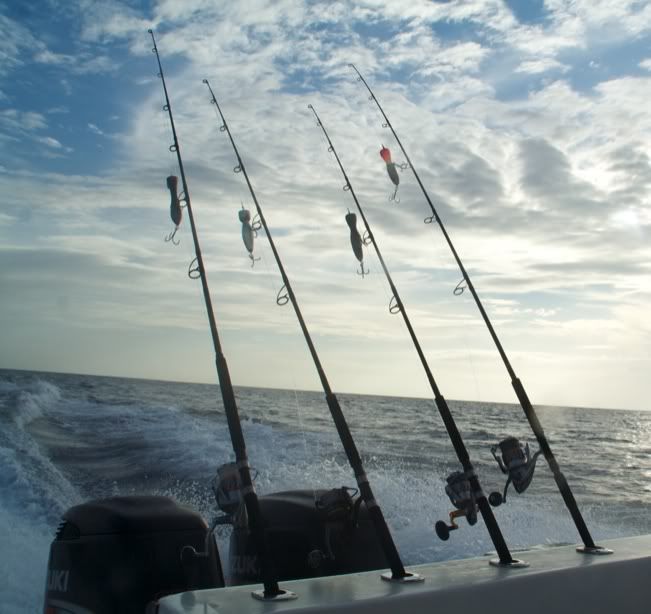
SCOUTING - Most of this style fishing is done on center console boats in the run and gun style, which means you, will drive around all day looking for pods of tuna to cast to. It is important that you all help looking for fish in different directions so you can be more efficient with your time.
CASTING – We all get excited when we see fish busting but it is important that we try to be patient and read the tunas direction and cast in front of them. You may not get many shots so you need to make teh best of it
KEY - Do not leave you lure dangling in water feet from the boat as both yellowfin and bluefin have a tendency to follow lures right up to boats edge last year we lost many shots as we stopped popping to early and fish actually came up missed popper and hit boat

SCOUTING - Most of this style fishing is done on center console boats in the run and gun style, which means you, will drive around all day looking for pods of tuna to cast to. It is important that you all help looking for fish in different directions so you can be more efficient with your time.
CASTING – We all get excited when we see fish busting but it is important that we try to be patient and read the tunas direction and cast in front of them. You may not get many shots so you need to make teh best of it
KEY - Do not leave you lure dangling in water feet from the boat as both yellowfin and bluefin have a tendency to follow lures right up to boats edge last year we lost many shots as we stopped popping to early and fish actually came up missed popper and hit boat
My FAVORITE - Fighting
STYLE OF FIGHT - In the beginning of a tuna fight I believe in sticking it to the fish as hard as I can with heavy drag to se how it reacts, it will either come up quick or become what some of us refer to as a demon fish. Either way if you get on them quick you can determine the style of fight.
Fighting with a spinning rod and reel and no harness looks hard but with the right technique you should be able to fight even the largest tuna for extended periods of time without severe trauma. The biggest mistake made is to pull with your arms.
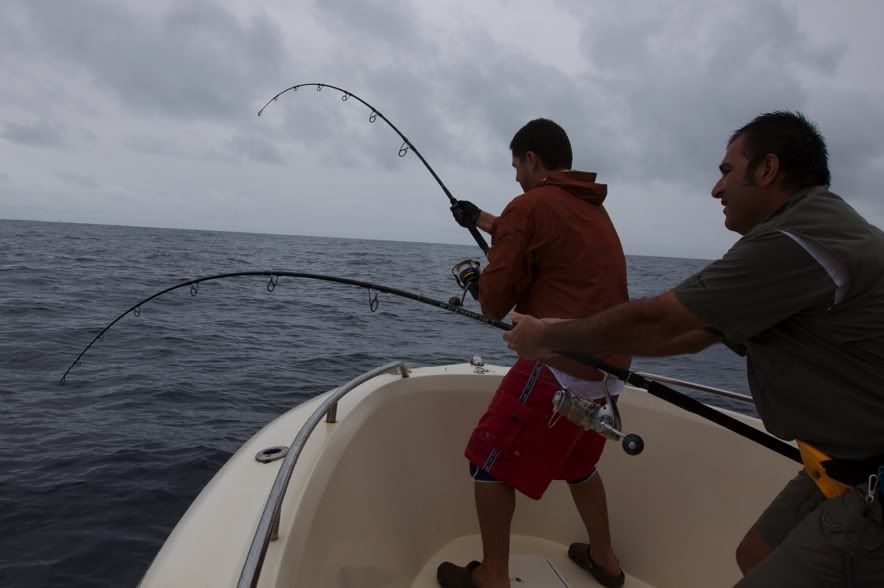
LOCKED ARM TECHNIQUE - Lock your support or non reeling arm straight and high on grip, then bend backwards with your legs and waist this will reduce your fatigue. Similar to using a harness but instead of straps your locked arm is the leverage point. Think of using your arms like a brace/lever instead of a joint, if not it will kill you on long fight to pull at the elbow. Whenever you pull back use both arms locked out NOW when you start to tire use ... one arm high BUT this is KEY pull with the other from the reels HANDLE not the high arm, this can help you get your arm back
I was fighting a 200 pound class yellowfin in this sequence and at no time did i feel really fatigued with close to 25 pounds of drag and 30 minutes of fighting time
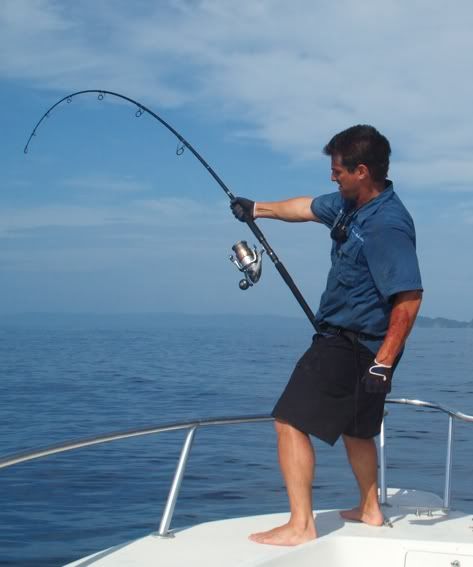
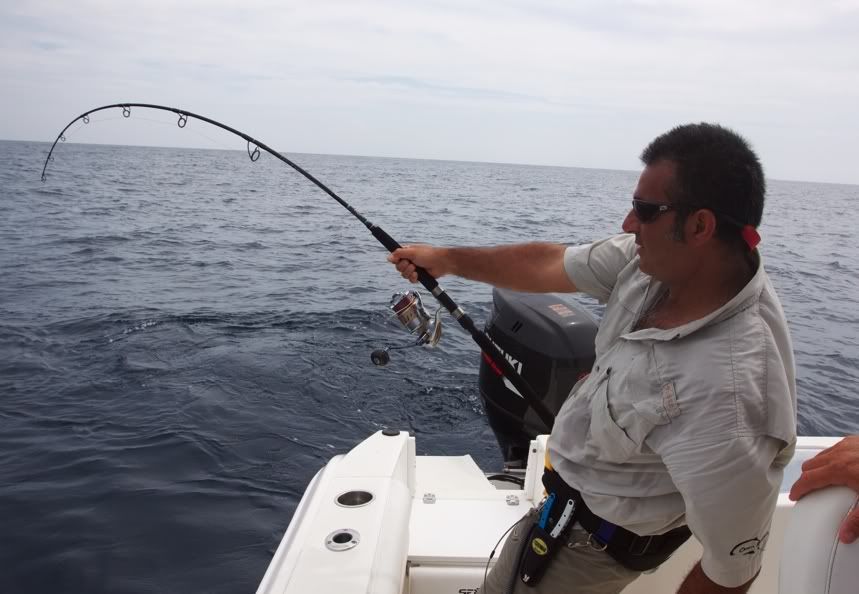
FIGHTING ANGLES - If your feet are at the 6 o'clock position and your head is at the 12 o'clock position your fighting range should be from 8-11 o'clock. Shorter more powerful strokes on big fish. With stripers and smaller tuna your fine From 11-12 o'clock you are actually working against your self because you are creating slack you cant catch up with which means the fish has room to wiggle
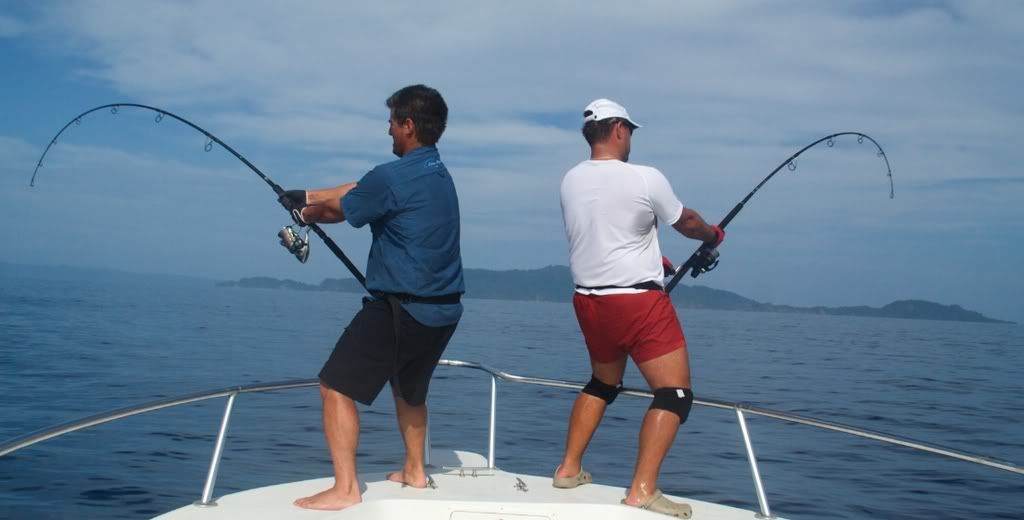
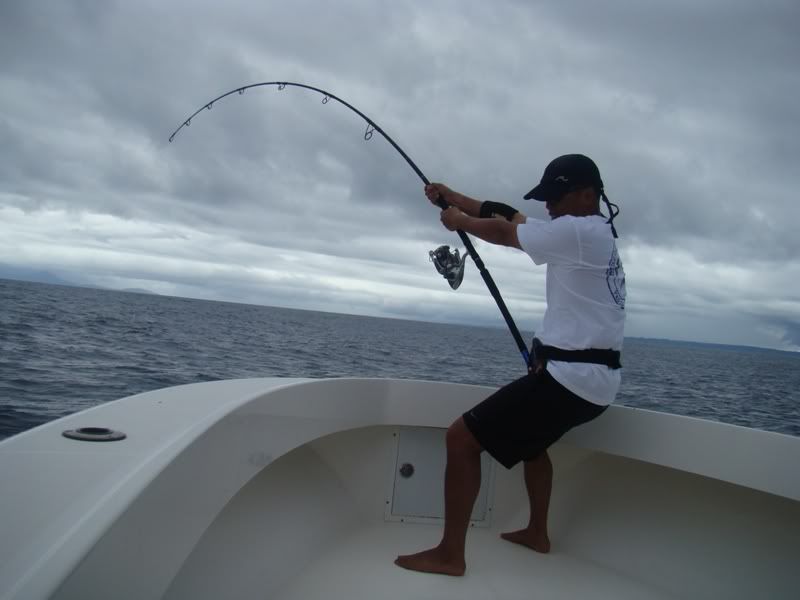
TIP – remember when fighting a big tuna … line either comes off the reel or on the reel. No resting if you’re resting so is the tuna. Max pressure equals shorter fight time
Closing
I have been blessed to have had the opportunity to fish with some of the worlds best in casting and jigging, I take no credit for anything displayed here other than it is a recap of what many many people have taught me. My hope is that this may help integrate a really great style of hardcore extreme fishing into your trips that will land slob tuna's on your deck
Before I forget all products listed here are available from the following companies, as most of the jigging tackle is hard to find
Anglers Pro Shop Angler's Pro Shop
Kilsongs Jigging world Network Solutions E-Commerce Web Site
Ocean Tackle International Ocean Tackle International
Cape Cod Tuna Season cant come quick enough
Tight Lines Glenn aka Gman ..........
Sami & Huge Bigeye on Popper



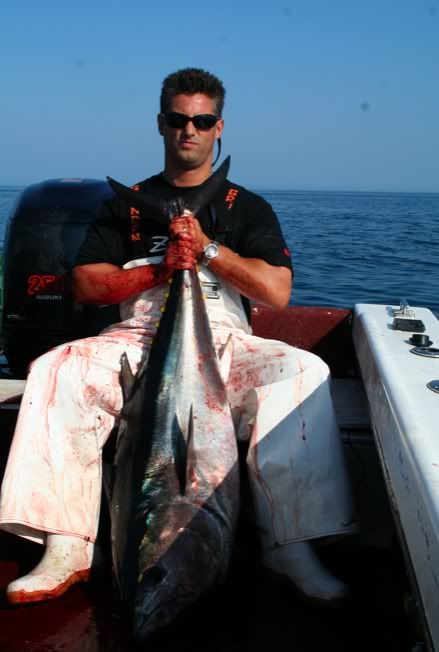
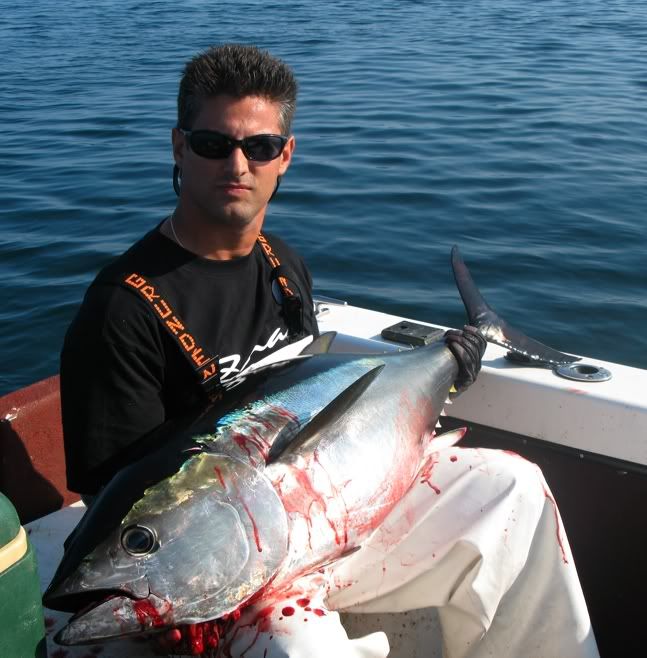
Before I forget all products listed here are available from the following companies, as most of the jigging tackle is hard to find
Anglers Pro Shop Angler's Pro Shop
Kilsongs Jigging world Network Solutions E-Commerce Web Site
Ocean Tackle International Ocean Tackle International
Cape Cod Tuna Season cant come quick enough
Tight Lines Glenn aka Gman ..........
Sami & Huge Bigeye on Popper






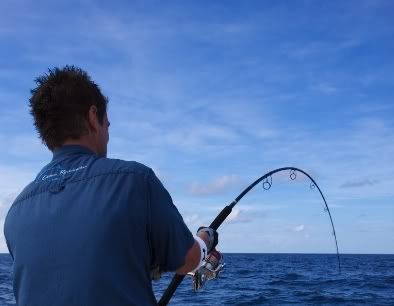
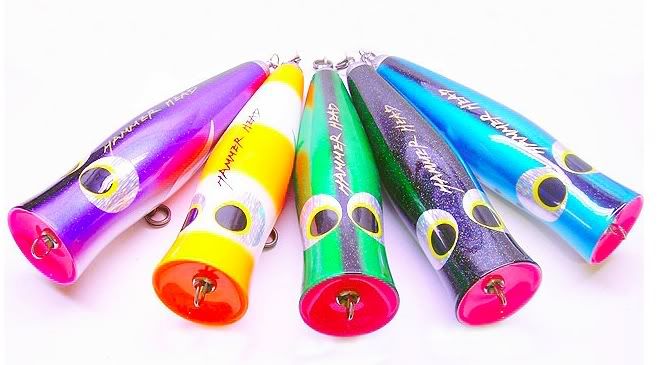
No comments:
Post a Comment